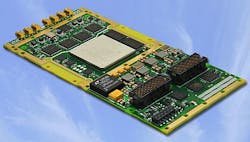Analog I/O XMC for military radar and image processing introduced by Curtiss-Wright
HIGH WYCOMBE, England, 17 Jan. 2013. Curtiss-Wright Controls Defense Solutions in High Wycombe, England, is introducing the XF07-516 analog I/O Express Mezzanine Card (XMC) based on the Xilinx Kintex-7 field-programmable gate array (FPGA) for high-end defense and aerospace applications like radar and imaging processing.
The XF07-516 is a high speed quad-channel 250-megasample-per-second analog input XMC (ANSI/VITA 42) with onboard user-programmable Xilinx Kintex XC7K325T FPGA for combining data acquisition and user algorithms.
The module has four channels of high-speed analog I/O, supports two banks of 128Mx16-bit DDR3 SDRAM, each connected to the FPGA. Each memory bank connects independently to the FPGA for read or write bandwidths greater than two gigabytes per second.
The XF07-516 supports a x4/x8 PCI Express channel through the primary XMC P15 connector using the FPGA's built-in PCI Express end-point block.
Alternatively, with customer HDL development, the XMC P15 also can provide user-defined protocol support over the data links, such as Aurora. The board's development kit includes software, HDL, utilities, and examples for using the XF07-516.
The kit includes a C programming language API, driver framework, and DMA support. A framework for adding in new IP functionality or capabilities to the FPGA is included.
Software utilities for configuring the FPGA include FLASH programming and configuring the FPGA from one of several indexed images in stored in FLASH. Other software support includes VxWorks and Linux Fedora. Support for Windows or other distributions can be considered on request.
The module is available in commercial, air-cooled rugged, and conduction-cooled versions.
For more information contact Curtiss-Wright Controls Defense Solutions online at www.cwcdefense.com.

